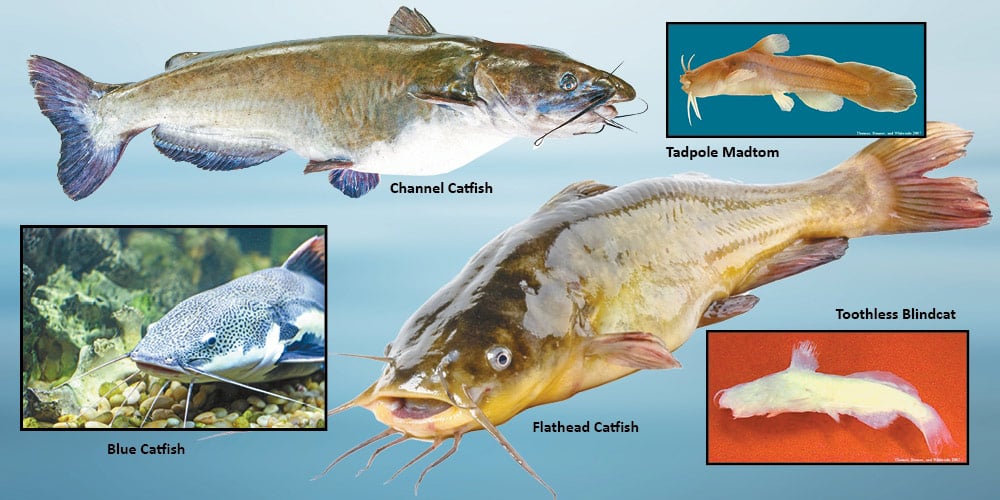
By Matthew R. March, MNRD
Polk County Extension Agent
How many species of freshwater catfish can you find in Texas streams? I suspect most people would answer three to four accounting for the most popular and common catfish like channel, flathead, blue and bullhead. However, Texas streams are home to 11 catfish species from the blue catfish that can top the scales at 130 pounds to the toothless blindcat measuring only four inches in length.
All of Texas 10 native freshwater catfish species belong to the bullhead catfish family or Ictaluridae. The bullhead catfish family is the largest freshwater catfish family in North America with at least 45 species. However, it is just one of 30 catfish families around the world containing over 2,200 species. Bullhead catfish have four pair of barbels (whiskers), no scales, an adipose fin and spines in the dorsal and pectoral fins. One non-native species, suckermouth catfish belongs to the suckermouth catfish family or Loricariidae. Suckermouth catfish can be found in portions of central and south Texas because of aquarium releases. The fish are invasive and it is believed can and may already be impacting native fish and aquatic ecosystems in Texas. Texas is also home to saltwater catfish such as the hardhead which belong to Ariidae family. These catfish sometimes can be found in streams near the coast, but we will not be covering these species today.
The three most economically important catfish as a game fish and/or for aquaculture is channel, blue and flathead catfish. Channel catfish can be found statewide from small streams to large lakes. This is the species commonly stocked in stock tanks and park ponds. Channel catfish can reach lengths over 40 inches and weigh up to 40 pounds, but individuals are usually smaller. Blue catfish and flathead catfish are the two heavyweights in Texas. Both can weigh over 100 pounds, however, adult flatheads feed mainly on live fish compared to other catfish species such as blue catfish that are mainly scavengers. Flathead catfish can be found statewide, while blue catfish are found statewide except for the Panhandle and parts of west Texas. Both species can be found in lakes, rivers and creeks with deep pools.
Related Articles
Texas is home to both the black bullhead and yellow bullhead which are very similar. Both can be abundant in lakes, ponds, rivers and creeks with backwater areas. Though these two species are common they are not usually sought by anglers due to their small size. Most individuals are 12 inches in length or less and weigh no more than a pound or so. Black bullhead have black chin barbels while yellow bullhead have yellow or white chin barbels. Both species are found throughout most of the state except for parts of far west Texas and the panhandle.
Madtoms are like miniature catfish and Texas is home to two species. Tadpole madtom and freckled madtom can be found in rivers and creeks throughout the eastern half of Texas except for far south Texas. Neither species is usually more than five inches in length and have a rounded caudal fin (tail fin) that connects to the adipose fin. Madtoms are also known for their venomous spines that can be compared to a bee sting. Distinguishing between the two species can be difficult and requires comparison of jaw structure and if a thin dark mid lateral stipe is present.
Texas is home to three catfish species that can be found nowhere else outside of Texas. Headwater catfish are nearly identical to channel catfish. One difference is headwater catfish have 22-26 anal fin rays while channel catfish have 27-29 anal fin rays. Headwater catfish native range is spring-fed rivers and creeks in the Pecos and Rio Grande River drainages of central west Texas, New Mexico and Mexico. Their range has now been restricted to lower Pecos River and Devils River in Texas.
The strangest catfish in Texas must be the toothless blindcat and widemouth blindcat. These two species are adapted to living in complete darkness in underground aquifers with such adaptions as no eyes and loss of pigmentation. Both species are known from five artesian wells in the San Antonio area. These wells arise from the Edwards Aquifer and both species can be found in the aquifer at depths of 976-1862 feet. Both species are listed as threatened because of pumping of the Edwards Aquifer and potential pollutants from surface water runoff.
While channel, blue and flathead catfish may steal all the attention from anglers, Texas is home to a variety of catfish species from tadpole madtom that looks like a miniature catfish to the completely blind and white widemouth blindcat.
You are a guest
or post as a guest
Be the first to comment.

